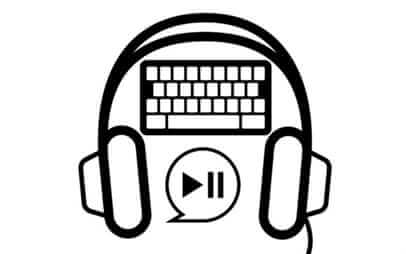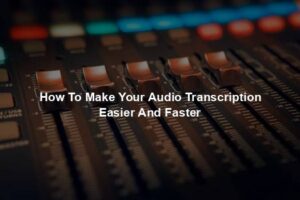
How Do You Make Your Transcription Fast And Easy?
As a transcriptionist, your wages are directly dependent on your transcription speed. This means that stepping up your transcription game can lead to direct financial gain, making every minute of work more rewarding.
By the end of this post, I hope would have answered the following questions:
- How can I increase my transcription speed?
- How long does it take to transcribe a 1-hour audio or video interview?
- Is there an easy way to transcribe audio?
How Can You Increase Your Transcription Speed? 14 Tips!
- Transcription requires concentration, good listening skills, a fast typing speed and sitting down for hours on end. Your typing speed, grammar, punctuation, listening skills need to be summoned when you sit down to transcribe. How, therefore, can you achieve accurate, editable transcripts within a limited amount of time? Let us go through some of the tips that can use to achieve this, despite the time constraint.
1. Transcribe Audio And Video Files In Smaller Chunks.
- Since transcription is tedious, one of the easy ways to transcribe faster is to segment your audio and video transcription tasks into batches. For example, a 1-hour audio file can be segmented into 10-minute files to make it easier to transcribe.
- How this works is that you trick your brain to seeing a lesser file that you can tackle in one sitting, take a break and then get back to working on another 10-minute file.
- Concentration is critical to delivering an error-free transcript and transcribing shorter files makes it easy to work on a file without getting bored or losing concentration. Transcribing one-hour audio or video file in one sitting can result in adverse health effects and loss in concentration.
2. Find a Good transcription software Program
- When you’re producing content, whether that’s a video program or an extensive research paper, you know how valuable time is. With so much to do, being able to rely on tools to automate some of your daily tasks is incredibly valuable.
- If you’re transcribing videos yourself, at the very least you’ll need to install special transcription software to enable audio playback using just your keyboard or a foot pedal. This eliminates the frustration of constantly using your mouse to start and stop the audio. There are also web-based transcription tools that let you upload and transcribe your entire recordings online. These are your best friends in getting transcripts done–fast.
- The following transcription programs have limited free versions with affordably priced upgrades:
- Express Scribe by NCH Software (Mac or PC)
- InqScribe (Mac or PC)
- The FTW Transcriber (PC)
- Use an Autocorrect Tool
- Going back to correct a misspelling takes precious minutes from your transcription time, so use QuickCorrect for WordPerfect, AutoCorrect for Microsoft Word or any other correcting tool to maximize efficiency. Just remember to carefully edit your piece in case the tool changed one of your misspellings to the wrong word.
3. Leverage The Use Of A.I. Powered Transcription Tools
- We are in the age of A.I and Machine learning and one of the easy ways you can speed up your transcripts is automatically transcribing your audio and video files.
- Let’s look at some advantages and disadvantages of using automatic transcription tools.
- Advantages of using Automatic transcription tools:
- It helps save time.
- Speeds up a tedious process.
- Does the heavy lifting, especially when you’re not conversant with different accents etc.
- You can make more money since you might end up working on more files.
- Disadvantages of Automatic Transcription tools:
- Result in a lot of wasted time (especially when the audio is not clear).
- Excessive editing and re-punctuating.
- Some applications require you to pay to use.
- Advantages of using Automatic transcription tools:
- There are pros and cons to everything. The quality of an automatically generated transcript is influenced by many factors.
4. Outsource Transcription Work.
- Outsourcing freelance work is one of the best ways to transcribe a lot of audio and video files. It involves delegating different files to different people that will help you get transcripts faster especially when you’re on a deadline. Outsourcing requires one to work with transcribers that they’ve worked with before and know the kind of quality transcript each transcriber provides. There’s nothing worse than outsourcing a 5 minute audio for transcription only to get it 2 days later and with tons of mistakes.
5. Take Breaks.
- There’s nothing more refreshing than taking a break from transcription or any work for that matter. You can take a water break to stretch, take a walk, nap or do something different. This helps your brain rejuvenate and get back the focus that you’re probably losing from working long hours.
The promodoro Technique, a time management technique, breaks down work into intervals helping you do more and have fun while at it. If you want to transcribe more audio files and faster, incorporate breaks in your workflow.
6. Use Text Expanders.
- Text Expanders are applications that you can use to quickly and easily increase your typing speed and productivity at the keyboard. They work well with words and phrases that are constantly mentioned and it is very easy to configure most text expanders to your liking.
- Text expanders can be used to speed up transcription especially for repetitive words and phrases and this, in turn, helps save time, improve accuracy and help transcribers make more money because transcribers can easily output more work. Here are some popular Text Expanders that you can use to increase your typing speed.
- – Instant Text pro7
- – Short Hand 10
- -PhraseExpress
7. Use a Foot Pedal
- A foot pedal lets you control dictation playback with your toes. You can play, rewind, and fast forward by tapping sections of the pedal with your foot. A foot pedal is a very valuable tool that can help you increase your speed when transcribing.
- It helps you type faster because you can configure the foot pedal to rewind, play and fast forward your audio without taking your hands off the keyboard by tapping on different sections as you’ve configured.
- USB foot pedals are the most commonly used with the Infinity USB Foot Pedal being the most recommended.
8. Improve your Typing Speed.
- Your typing speed dictates how much time it takes to transcribe 1-hour audio. If you’re a slow typer then this means that it will take you more time to finish transcribing and this can result in rejected work, long sitting hours that can lead to backaches, etc.
- Most transcription companies that hire freelancers have a required typing speed of above 60 words per minute. This helps them output more transcripts with a better turn-around for their clients. Practice is one of the most obvious ways to increase your transcription speed, and it is also one of the most important. You can also take a typing class or download a good typing program to learn proper touch-typing technique.
- After honing your own skills, measure your realistic transcription time for an audio segment to determine the minimum you’re willing to charge. There are numerous ways to test your typing speed, for example at typingtest.com to see how fast you type and rate yourself.
9. Work in a Quiet Environment and (or) Use Noise Cancelling Headphones
- A quiet environment increases productivity and boosts concentration. Being able to focus your full attention on the audio is crucial for quick transcribing, so find a work environment with few noises and distractions. If possible, complete your transcriptions in a closed home office. Ample workspace and a comfortable or ergonomic chair create a huge difference in keeping your body relaxed during hours of transcription work. It supports your lower back, promotes good posture, and ensures proper blood circulation. Adjust the seat to your preferred position. Keep in mind that even the best transcriptionist can take up to three hours to transcribe one hour of audio, depending on factors such as language technicality, formatting requirements, and fast-paced speech patterns.
- Even more important than typing speed is your ability to hear and correctly transcribe words as they are spoken. For clearer audio that lets you hone in on the speaker’s voice, invest in a noise-canceling stereo headset. When you do not have the luxury of a quiet working environment, noise-canceling headphones come in handy. These types of headphones help block the noise from outside and keep you glued to what you’re listening to and in this scenario the audio that you’re transcribing. In return, this helps you work on more files while escaping the distraction that can result in slow typing speed and more time working on the same file.
- Over-ear headsets are the most comfortable as they encase your entire ear and isolate distracting noise. Human voice frequencies lie between 250 Hz and 2000 Hz, the midrange of sound. We recommend headphones that have a pronounced yet smooth midrange.
10. Choose your Audio Files Wisely.
- Although you cannot always have your way with audio and video files that you need to transcribe, before accepting work from a client or transcription sites, ensure that you have a listen to the audio file.
11. Communicate with your clients about their needs.
- Ask what kind of transcript they want, what the purpose of the transcript is and what information is important to them. Inform clients that the type of transcript they need will affect the time to transcribe it and the cost. Strict verbatim transcription will take longer to transcribe than intelligent verbatim. Intelligent verbatim transcription cuts out redundant words, repeats, pauses, ‘ums’ and the ‘ers’, fillers such as kind of, sort of, you know. Find out if you can skip parts of the content that are unimportant to them and save transcription time. You may not need to transcribe background noise and other sounds that are not made by the participants.
12. Ask for documentation.
- Ask clients to provide a list of unusual words or other documentation that includes many of the terms used during the recording such as the name of the project, jargon and any technical, specialty, abbreviations or other unfamiliar terms. Ask for the speakers’ names and other names mentioned or ask to spell them at the beginning of the recording.
13. Transcribe topics you’re familiar with.
- When getting started, start with easier jobs that don’t include specialized terminology and work for industries you’re familiar with. If you’re transcribing topics you’re not familiar with, you’ll have to do some research and look up unfamiliar words which will slow you down.
14. Become familiar with the terminology and jargon of the industries you’re working with.
- Each industry has specific terminology and jargon associated with it. Become familiar with them. The longer you work with the same company or industry, the more familiar you will be with the words and phrases that they use. To become faster at transcribing certain topics and be able to figure out hard-to-hear words, look up the definitions, meaning, and spelling of words your clients often use.
Step By Step Process To Achieve Faster Transcription
Step 1. Prepare Your Tools and Equipment
- Make sure you’ve prepared all the necessary tools and equipment before you begin to transcribe.
- Keep your essential every day carry items close. Eyeglasses, a bottle of water, a cup of coffee, or a mobile phone should have already been placed on your desk to reduce distractions while doing transcription work.
- An online reference such as soft copies of a dictionary or Google helps you quickly search for unfamiliar terms and the context to its meaning.
Step 2. Use a Good Transcription Software
- There are web-based transcription tools such as Scribie that let you upload and transcribe your entire recordings online. These are your best friends in getting transcripts done–fast.
Step 3. Amplify Volume and Increase the Audio Quality
- Not all recordings are made equal. If you have a difficult file with plenty of background noise, there are ways you can increase its audio quality. Different software have in-built capabilities to help you with this.
Step 4. Familiarize Yourself with the Tools
Make the most out of your transcription software. Buckle up for your transcription journey by getting to know your tools. Figure out the built-in tools, keyboard shortcuts, and the control panel of your software. Customize it to fit your work process.
Step 5. During Transcription
- Here’s a pro tip: Many transcribers put speech to text by matching the transcript and audio word-for-word. We actually recommend against that. Instead, listen to the entire conversation and use context to interpret and identify the correct words.
- During transcription, you may come across unfamiliar content such as technical or medical terms. Do a Google search for context or install soft copies of an online dictionary for a quick definition.
- Don’t get hung up on a difficult word, though. There may be certain terms or words that are difficult to catch where you end up pausing and rewinding multiple times. Skip them. Leave a blank in the meantime and get back to those words you missed later to avoid breaking your flow.
- Avoid context switching and juggling different tasks at the same time. Alternating between transcribing and editing becomes tiresome. Instead, do one thing at a time.
- Begin the task by putting on your transcription hat and focusing on the transcription task ahead. The first draft doesn’t have to be perfect. Once you’ve completely transcribed the entire recording, whether manually or automatically, you can pivot your attention to editing and refining the transcript.
Step 6. Edit the Transcript
- Re-play the audio, go over your draft identify and correct:
- Areas left blank or missed
- Misheard words, terms, or expressions
- Misspelled words
- Punctuation
- Formatting
What Features Should Be Incorporated Into A good Transcription Software?
- The word expander saves time by predicting and expanding the word you’re typing. Frequently used words allow an overview of what words to expect in your recording. This saves you from guessing a vague term.
- Spellcheck provides you with suggestions to autocorrect any potential spelling mistakes.
- Slow down or speed up audio to catch every word.
- Keyboard shortcuts to pause, skip, forward, or rewind to a certain time in the recording.
- Identify mistakes.
- For recordings with heavy accents, there should be a dictate and transcribe feature using voice recognition software.
- If you happen to have little idea of your recording’s content, you should have the option to automatically transcribe your file. This gives you a nice overview of what to expect and speeds up transcription.
An example of such software is scribe.
What Factors Determines How Long It Takes To Transcribe Audio Or Video?
Transcription time, no matter how long you’ve been creating audio transcriptions, can be greatly affected by a few factors. Of course, a professional will overcome these obstacles faster than the average person, but one-hour transcription can be doubled or tripled in time depending on audio recording quality, background noise, regional accents, and potential research needed. Below are Some Of the Factors that will affect the speed of transcription.
1. Audio Recording Quality
- The overall quality of the audio recording has a major impact on the transcription speed. It’s important to test your devices, especially the placement of the microphone before you begin your recording. Make sure that your audio is clear and no speaker is muffled when they talk.
2. Background Noise
- Another major factor to consider is the environment where you’re recording. Background noise can make it impossible to hear important phrases or entire sections of your audio recording. If the transcriber has to rewind constantly to try to decipher what’s being said, the transcription time will most definitely go up.
3. Regional Accents
- Depending on the transcriber’s native language, regional accents can have an effect on average transcription speed. The closer an accent is to their native language, the easier time they will have transcribing your audio file. However, speakers with thick accents or those who switch between two languages as part of their speech pattern might make the transcription more difficult. Consider this when you’re thinking about how to transcribe your audio file.
4. Potential Research Needed
- Tough topics can also add to your overall average transcription time. Students, professors, and law professionals can be affected by this hurdle most often. If the topic of your audio file is particularly complicated, or the speakers use complex words, it will add time to your transcription speed. Of course, if you know the topic well and don’t need to do additional research to understand what’s being discussed, this might not add to your transcription time.
What Is The Average Transcription Speed for the Average Person?
- The average person can transcribe one audio hour in about 4 hours. It takes most people about one hour to transcribe 15 minutes of a clear, slow audio file. If any of the factors we mentioned above change the quality of the recording, that time might go up.
What Is The Average Transcription Speed for the Professional Transcriptionist?
- For professional transcriptionists, the average time to transcribe one audio hour ranges from 2-3 hours. Some of the most qualified transcriptionists can transcribe up to 30 minutes of audio in an hour. When time is an important factor in your decision, there’s no way to beat the speed of a professional transcriptionist.
Conclusion
In summary, if you’re looking to transcribe audio and video files faster you need to,
- Transcribe smaller segments of audio and video files
- Use automatic transcription tools
- Leverage The Use Of A.I. Powered Transcription Tools
- Take breaks to rejuvenate
- Outsource your transcription gigs
- Use text expanders to help you type faster
- Use a foot pedal to help you expand words that you type frequently
- Improve your typing speed to touch-typing speed.
- Work in a quiet environment or use Noise-cancelling headphones
- Choose your audio and video files wisely before accepting a transcription project.
- Communicate with your clients about their needs.
- Ask for documentation.
- Transcribe topics you’re familiar with.
- Become familiar with the terminology and jargon of the industries you’re working with.
Transcription work can be rewarding for those with an eye for detail and quality content. Breaking the transcription process down into step-by-step increments makes long hours seem easy and do-able. Remember, a great transcription software saves time and effort.







